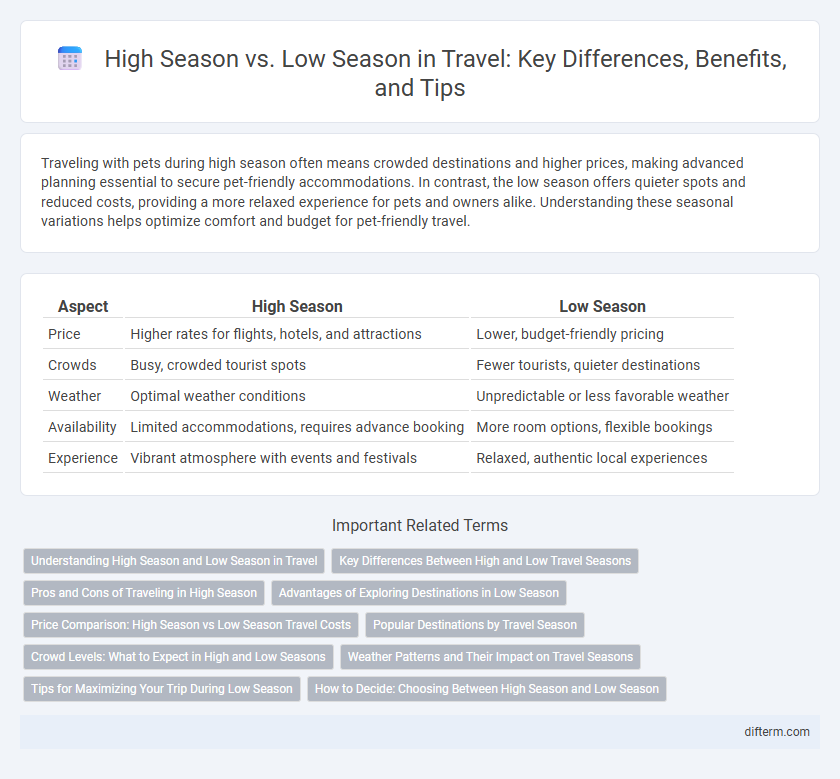Traveling with pets during high season often means crowded destinations and higher prices, making advanced planning essential to secure pet-friendly accommodations. In contrast, the low season offers quieter spots and reduced costs, providing a more relaxed experience for pets and owners alike. Understanding these seasonal variations helps optimize comfort and budget for pet-friendly travel.
Table of Comparison
| Aspect | High Season | Low Season |
|---|---|---|
| Price | Higher rates for flights, hotels, and attractions | Lower, budget-friendly pricing |
| Crowds | Busy, crowded tourist spots | Fewer tourists, quieter destinations |
| Weather | Optimal weather conditions | Unpredictable or less favorable weather |
| Availability | Limited accommodations, requires advance booking | More room options, flexible bookings |
| Experience | Vibrant atmosphere with events and festivals | Relaxed, authentic local experiences |
Understanding High Season and Low Season in Travel
High season in travel refers to periods when demand, prices, and tourist crowds peak, typically during holidays, summer months, and major festivals. Low season occurs during off-peak times, often in colder or rainy months, offering lower prices, fewer crowds, and more availability at destinations and accommodations. Understanding these seasonal patterns helps travelers optimize their budget, experience, and itinerary by strategically choosing travel dates.
Key Differences Between High and Low Travel Seasons
High travel season is characterized by peak tourist influx, higher accommodation rates, and increased demand for flights and attractions, typically occurring during school holidays and major festivals. Low travel season offers fewer crowds, lower prices on lodging and airfare, and more relaxed experiences at popular destinations, often aligning with off-peak weather conditions or shoulder months. Understanding these key differences enables travelers to strategically plan trips for cost savings or vibrant cultural events.
Pros and Cons of Traveling in High Season
Traveling in high season offers vibrant cultural events, optimal weather, and bustling attractions, enhancing the overall experience for tourists. However, higher prices for accommodations and flights, along with larger crowds at popular sites, can impact comfort and budget. Planning well in advance and booking early are essential strategies for maximizing benefits during peak travel periods.
Advantages of Exploring Destinations in Low Season
Traveling during the low season offers significant advantages such as lower accommodation and flight prices, allowing for a more budget-friendly vacation. Tourist attractions and destinations are less crowded, providing a more authentic and relaxed experience while enhancing opportunities for personalized interactions with locals. Weather conditions in the low season often remain pleasant, enabling travelers to enjoy popular sites without the typical high-season congestion.
Price Comparison: High Season vs Low Season Travel Costs
Travel costs during high season can be up to 50% higher compared to low season due to increased demand for flights, accommodations, and tour services. Budget-conscious travelers benefit from significant savings during the low season, with discounted hotel rates and airfare promotions typically available. Understanding seasonal price fluctuations allows for strategic planning to maximize travel budgets and access better deals on popular destinations.
Popular Destinations by Travel Season
Travelers often flock to popular destinations during the high season, such as beach resorts in the Caribbean from December to April, when weather conditions are ideal and attractions are fully operational. In contrast, the low season, typically from May to November, offers fewer crowds and lower prices in destinations like Southeast Asia and Southern Europe, though some services may be limited due to weather patterns or off-peak maintenance. Understanding the seasonal patterns of top travel destinations allows travelers to optimize their itineraries based on preferences for climate, cost, and crowd density.
Crowd Levels: What to Expect in High and Low Seasons
High season in popular travel destinations typically sees a significant surge in crowd levels, resulting in crowded attractions, longer wait times, and higher demand for accommodation and services. Low season offers a more tranquil experience with fewer tourists, shorter lines, and often better deals on hotels and flights. Travelers seeking a balance between pleasant weather and manageable crowd sizes often choose shoulder seasons for optimal conditions.
Weather Patterns and Their Impact on Travel Seasons
Weather patterns significantly influence travel seasons, with high season typically coinciding with favorable climate conditions such as warm temperatures and low rainfall. Destinations experience peak tourist inflows during dry, sunny periods, which enhance outdoor activities and sightseeing opportunities. Conversely, low season often aligns with adverse weather conditions like heavy rains or extreme cold, reducing traveler demand and offering quieter, less crowded experiences.
Tips for Maximizing Your Trip During Low Season
Traveling during the low season offers advantages such as fewer crowds, lower prices, and a more authentic experience. To maximize your trip, prioritize visiting popular attractions early in the day to avoid local maintenance closures and take advantage of discounted accommodation rates by booking in advance. Consider exploring off-the-beaten-path destinations and local events to fully experience regional culture without the high season tourist influx.
How to Decide: Choosing Between High Season and Low Season
Choosing between high season and low season impacts travel costs, crowd levels, and available activities. High season offers vibrant events and optimal weather but comes with higher prices and busy attractions, while low season provides affordability and tranquility with potential weather limitations. Assess personal preferences for budget, experience quality, and climate to make an informed decision tailored to individual travel goals.
high season vs low season Infographic

 difterm.com
difterm.com